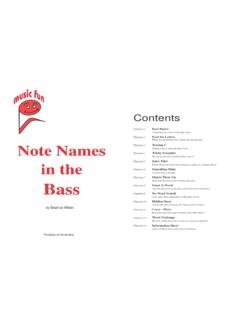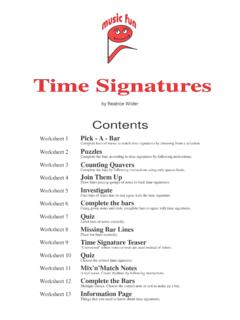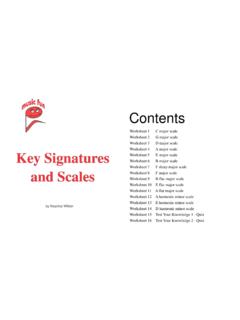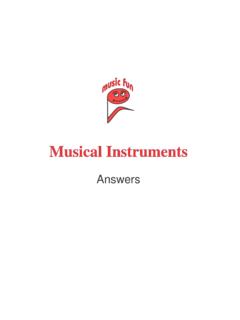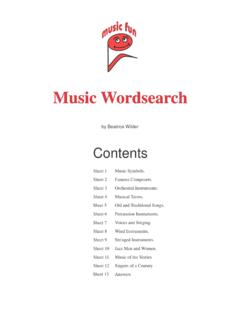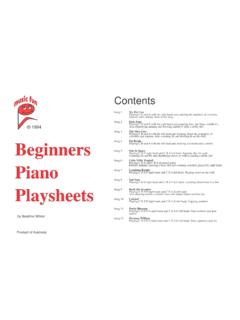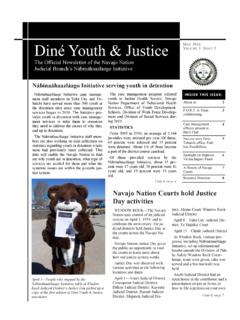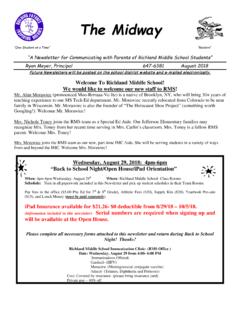Transcription of © 2012 Camille Saint-Saëns
1 Camille Saint-Sa ns-Danse MacabreThe Carnival of the AnimalsCamille Saint-Sa ns-Danse MacabreThe Carnival of the AnimalsContents 2012by Beatrice WilderSheet 1 Information about Saint-Sa nsSheet 2 Information about Danse Macabre Sheet 3 Information about Carnival of the Animals Sheet 4 Saint-Sa ns - the Composer (quiz)Sheet 5 Carnival of the Animals QuizSheet 6 Carnival of the Animals WordsearchSheet 7 The Carnival of the Animals Match UpSheet 8 Easy Carnival of the Animals Match UpSheet 9 Danse Macabre QuizSheet 10 Danse Macabre WordsearchSheet 11 Carnival of the Animals Crossword and Mini Wordsearch Sheet 12 Answers Copyright Beatrice Wilder 2012 Published in 2012 by Music Box 342 Katoomba NSW 278019 Millyard Lane Katoomba 2780 Phone: (02) 4782 3073 Fax: (02) 4782 6362 Email: feel free to contact us with any questions about the copying and use of our worksheets in your 1 - Information about Saint-Sa nsiSaint-Sa ns was born in 1835 in Paris, France, eight years after Ludwig van Beethoven died.
2 His birthday was October was christened Charles- Camille . His father was very ill with tuberculosis when he was born. When the baby Charles- Camille was three months old, his father his father died, his great-aunt Charlotte came to live with him and his mother, Cl mence. His great-aunt started teaching him to play the piano and soon discovered that he was a very clever little boy indeed. He had 'perfect pitch' which meant that he could sing in tune and reproduce musical sounds the age of two he was learning to play the piano. By the time he was three years old he was able to read and write as was interested in many subjects like astronomy, history, painting and animal welfare and was very good at made his first public concert appearance when he was five years old. He accompanied a Beethoven violin the time he was ten years old he could play all of Beethoven's piano sonatas by heart, and there were 32 of made friends with and won the respect and admiration of well known composers of his time such as Schumann, Berlioz, Rossini, Gounod, and became organist at some well known and prominent churches like the 'Church of Saint-Merry' in 1853 and 'La Madeleine' in 1857 where he stayed for nearly twenty years.
3 It was a very prestigious position and won him a lot of recognition. He was thought by many at the time to be the greatest organist in the 1874 he wrote 'Danse Macabre' and four years later, in 1878, he wrote Samson et Dalila. iThe next year, when he was 39 years old, he married 19-year-old Marie-Laure Truffot. They had two sons but sadly both of them died within a few weeks of each other, one from an illness and the other in a terrible accident. The little boy fell out of a 4th floor window. Saint-Sa ns blamed his wife for not preventing this and they were no longer able to get along. He left her in got closer to his mother, who had never much liked Marie-Laure, and after separating from her he also developed a stronger friendship with Gabriel Faur and his family, especially enjoying the company of the Faur children. They had a lot in common as Gabriel Faur was also a French pianist, organist and few years later in 1886, while they were on holidays, Saint-Sa ns wrote 'The Carnival of the Animals' to amuse his family and had a very close relationship with his mother and when she died in 1888, he became very depressed even to the point of thinking about ending his own life.
4 He decided that he needed to completely change his life and get away from everything that reminded him of his left France and travelled around the world. He seemed to have had a great fondness for the African continent and wrote a colourful piece of music which he called 'Africa' as well as his Piano Concerto No. 5, the "Egyptian."iHe died of pneumonia on 16 December 1921 at the H tel de l'Oasis in Algiers. His body was sent back to France and a state funeral was held for him at 'La Madeleine' where he was organist many years earlier. He was 86 years old and had spent some 80 years of his life creating a great variety of musical .. 2012 Camille Saint-Sa nsCamille Saint-Sa nsSheet 2 - Information about 'Danse Macabre'Name .. 2012 Camille Saint-Sa nsCamille Saint-Sa nsiDanse macabre, Op 40, is a symphonic poem composed by Saint-Sa ns in 1874. He first wrote it as a song. The words were written by Henri 12 notes, all 'D,' are played on the harp.
5 This is the clock striking after the clock strikes 12, death tunes his violin. One string, the 'E' string, is tuned flat to provide a more ghostly sound. Death is summoning the dead to come out of their graves and to dance the 'Dance of Death' for flute introduces the theme which is followed by a solo violin. The skeleton dance begins. iAs the dance continues you can hear the bones of the skeletons rattling as the xylophone plays. We can imagine ghosts, skeletons and witches dancing together through the night as death continues his sad solo on the violin, at times accompanied by the woodwind section is made up of the piccolo, 2 flutes, 2 oboes, 2 clarinets and 2 brass section consists of : horns, trumpets, trombones and the string section look for: a harp, violins, violas, cellos and double the percussion section you will find: timpani, xylophone, bass drum, cymbals and dance becomes wilder. You can hear the strings, the trombone and the xylophones making the skeletons bones rattle wildly.
6 Listen for the witches flying when you hear the strings, listen too for death tuning his violin again and for the wind to oboe announces the end of the night. The cock crows and morning is dead very quickly and suddenly slip back into their day dawns and the violin plays a new theme. The picture completely changes and everything is back to English translation of the words of Henri Cazalis:Zig, zig, zig, Death in a cadence,Striking with his heel a tomb,Death at midnight plays a dance-tune,Zig, zig, zig, on his winter wind blows and the night is dark;Moans are heard in the linden the gloom, white skeletons pass,Running and leaping in their , zig, zig, each one is frisking,The bones of the dancers are heard to crack But hist! of a sudden they quit the round,They push forward, they fly; the cock has opening bars of Death's Dance - listen for it and sing it to 3 - Information about 'The Carnival of the Animals'Name .. 2012 Camille Saint-Sa nsCamille Saint-Sa nsiThe Carnival of the Animals is a musical suite of 14 movements, written in 1886 for the amusement of his companions while Saint-Sa ns was on first movement is the lion.
7 The two pianos play scales moving in opposite directions to sound like the roaring of the lions while the strings provide a melody. The march theme reminds us of the stately, regal nature of the king of are the hens and roosters. The piano and the strings (violins and violas, no cellos or double basses) sound like chickens pecking at the grain. Listen also for the 'cock-a-doodle-doo' on the piano. iWild asses are fast moving as shown by the frantic pace of the scales being played by the two pianos without any orchestral slow moving tortoises are portrayed by the deep sounding strings accompanied by the pompous but lumbering waltz played by the double bass and piano introduces the elephants. iKangaroos are shy creatures. The two pianos also show their natural grace and aquarium. Strings, piano and flute and glass harmonica give the sensation of a light watery environment. A celeste or glockenspiel are often used instead of the glass harmonica.
8 It is interesting to note that the 'glass harmonica' is not really a harmonica as most of us imagine. It is a series of glass vessels of varying sizes. Friction is used to produce sound. Among other variations of the glass harmonica, wine glasses tuned with different volumes of water have been used. This is often referred to as a 'glass harp.'iThe 'personages with the long ears' are unmistakably donkeys. The braying of the donkeys is produced by the violins. This is the shortest of the comes the cuckoo in the forest. The clarinet produces the 'cuckoo' sound, gradually becoming softer as the sound is produced from deeper within the forest, to the accompaniment of the trills and scales on the pianos paint a picture of the birds in the aviary. The light but busy sounds produced by piano, flute and strings give the feeling of an industrious flock of little practicing their scales - but are they beastlike? Well, that can be open to debate and left to the imaginations of the listeners.
9 That they are practicing must surely be in a museum is possibly where Saint-Sa ns felt that some well known nursery rhymes and other well known and loved tunes should be placed. Strings, pianos, clarinet, and xylophone give the feeling of bones clacking together and displays of things old and swan is the best known of the movements. The cello provides the grace and elegance of the swan gliding over the water as the piano provides the soft ripples in the the finale, a carnival atmosphere with all of the instruments busy has us imagining all of the animals together with the donkey at the end having the last ns was born in:For nearly twenty years he was the organist atthe Church of:At midnight the clock strikes 12 in:In 'Carnival of the Animals' there is no:Saint-Sa ns built a reputation for being one ofthe worlds greatest:Saint-Sa ns died in 1921 in:A. St Paul'sA. Danse MacabreA. DonkeyA. OrganistsA. LondonB.
10 ParisB. Saint-MerryB. Samson et DalilaB. KangarooB. Music TeachersB. AlgiersC. La MadeleineC. EgyptianC. FishC. MathematiciansC. Paris D. St Peter's D. Africa D. Giraffe D. Composers D. New RomeC. Berlin D. Madrid His first instrument was the:A. PianoB. ViolinC. Organ D. FluteHis first public appearance, when he wasfive years old was to accompany a :A. Singer B. ViolinistC. Cellist D. FlautistBy the time he was ten years old he could playfrom memory all of:A. Wagner's OperasB. Schubert's LiederC. Beethoven's Sonatas D. Handel's MessiahHe did not get to know or make friends with:A. RossiniB. LisztC. Berlioz D. PurcellAfter the death of his mother, Saint-Sa ns: Saint-Sa ns developed a special fondness for:A.
